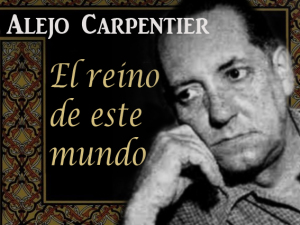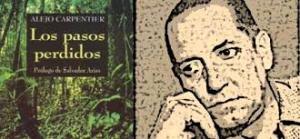 Alejo Carpentier y Valmont (December 26, 1904 – April 24, 1980) was a Cuban novelist, essayist, and musicologist who greatly influenced Latin American literature during its famous “boom” period. Born in Lausanne, Switzerland, Carpentier grew up in Havana, Cuba, and despite his European birthplace, he strongly self-identified as Cuban throughout his life.
Alejo Carpentier y Valmont (December 26, 1904 – April 24, 1980) was a Cuban novelist, essayist, and musicologist who greatly influenced Latin American literature during its famous “boom” period. Born in Lausanne, Switzerland, Carpentier grew up in Havana, Cuba, and despite his European birthplace, he strongly self-identified as Cuban throughout his life.
Carpentier was born to Jorge Julián Carpentier, a French architect, and Lina Valmont, a Russian language teacher. For a long time it was believed that he was born in Havana, where his family moved immediately after his birth; however, following Carpentier’s death, his birth certificate was found in Switzerland.
He traveled extensively, particularly in France, and to South America and Mexico, where he met prominent members of the Latin American cultural and artistic community. Carpentier took a keen interest in Latin American politics and often aligned himself with revolutionary movements, such as Fidel Castro’s Communist Revolution in Cuba in the mid-20th century. Carpentier was jailed and exiled for his leftist political philosophies.
With a developed knowledge of music, Carpentier explored musicology, publishing an in-depth study of the music of Cuba, La música en Cuba and integrated musical themes and literary techniques throughout his works. He explored elements of Afro-Cubanism and incorporated the cultural aspects into the majority of his writings. Although Carpentier wrote in a myriad of genres, such as journalism, radio drama, playwrighting, academic essays, opera and libretto, he is best known for his novels. He was among the first practitioners of magical realism using the technique, lo real maravilloso to explore the fantastic quality of Latin American history and culture. The most famous example of Afro-Cuban influence and use of lo real maravilloso is Carpentier’s 1949 novel El reino de este mundo (The Kingdom of this World) about the Haitian revolution of the late 18th century. He turned to journalism, working for the Cuban newspapers Carteles and Social. He also studied music.
When the Machado regime came to an end in 1933, Carpentier decided to make plans to return to his native land to visit, and in 1936 he made the trip back to Cuba. The time he had spent in Paris for over eleven years had enriched and “oriented his expressive abilities”. Carpentier himself indicated that he was tiring of Paris, and “…in 1939 without any other reason than the nostalgia of Cuba, I vacated my apartment and started the return to La Havana”.
Later life.
Carpentier returned to Cuba after Fidel Castro’s Communist revolution in 1959. He worked for the State Publishing House while he completed the baroque-style book, El Siglo de las Luces (Explosion in a Cathedral) (1962). This novel discusses the advent of the Enlightenment and the ideas of the French Revolution in the New World. It has twin leitmotifs of the printing press and the guillotine and can be read as a “meditation on the dangers inherent in all revolutions as they begin to confront the temptations of dictatorship.” After reading the book, Gabriel García Márquez is said to have discarded the first draft of One Hundred Years of Solitude and begun again from scratch.
In 1966, Carpentier settled in Paris where he served as Cuban ambassador to France. In 1975 he was the recipient of the Prix mondial Cino Del Duca. He received the Cervantes Prize[20] in 1977 and was recipient of the French Laureates Prix Médicis étranger in 1979 for La harpe et l’ombre.
Carpentier was struggling with cancer as he completed his final novel, El arpa y la sombra, and finally died in Paris on April 24, 1980. He was married to Lilia Esteban Hierro. His remains were returned to Cuba for interment in the Colon Cemetery, Havana.
Major works.
Carpentier’s major works include:
Ecue-yamba-o! (1933) (Praised Be the Lord!)
La música en Cuba (1946) (The Music of Cuba), an ethno-musicological study of Cuba starting from the sixteenth century, the arrival of European explorers, till the present day of publication, the mid twentieth century.
El reino de este mundo (1949) (The Kingdom of this World)
Los pasos perdidos (1953) (The Lost Steps)
El acoso (1956) (Manhunt)
Guerra del tiempo (1958) (War of Time)
El siglo de las luces (1962) (Explosion in a Cathedral)
El Recurso del método (1974) (Reasons of State)
Concierto barroco (1974) (Concierto barroco; English: Baroque Concert), based on the 1709 meeting of Vivaldi, Handel and Domenico Scarlatti, with cameo appearances by Wagner and Stravinsky, and fictional characters from the new world who inspire the Venetian composer’s opera, Motezuma.
La consagración de la primavera (1978) (The Rite of Spring; Le Sacre du Printemps, ballet by Igor Stravinsky)
El arpa y la sombra (1978) (The Harp and the Shadow) dealing with Columbus.
El reino de este mundo (The Kingdom of this World)
Carpentier’s El reino de este mundo (1949) highlights the Haitian Revolution of the 18th century when the African slaves fought the French colonists for their freedom and basic human rights.
La música en Cuba (The Music of Cuba)
Guerra del tiempo (The War of Time)
Guerra del tiempo (The War of Time) is a set of surrealistic short-stories, in a variety of styles, which evidences Carpentier’s ability to work with the fantastic and the surreal. The most important is the first one, “El Camino de Santiago” (The Way of Santiago), which narrates the adventures of a commoner, a Spaniard in the Age of Discovery, who is today a soldier, tomorrow pilgrim, then a sailor, a colonizer, prisoner, and so on; he pursues every dream and suffers every disappointment. The second tale is called “Viaje a la semilla” (Journey Back to the Source). This narrative is striking for the function of the time inversion that the narrator operates to tell the life of the main character, Don Marcial (Marqués de Capellanías).
Agencies/Various/Wiki/InternetPhotos/www.thecubanhistory.com
The Cuban History, Hollywood.
Arnoldo Varona, Editor.



 Alejo Carpentier, writer, musicologist. (Cuban descendant) ** Alejo Carpentier, escritor, musicológo. (Descendiente cubano)
Alejo Carpentier, writer, musicologist. (Cuban descendant) ** Alejo Carpentier, escritor, musicológo. (Descendiente cubano)
